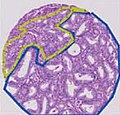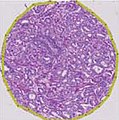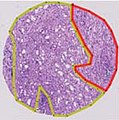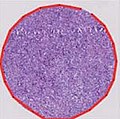Gleason score
The Gleason score is used for the histological (tissue) assessment of the condition of the glands ( morphology ) in the prostate tissue (compare: grading ). It serves as a prognostic value for prostate cancer and is established worldwide. The higher the value, the higher the degree of dedifferentiation and the worse the prognosis. A low value therefore stands for tissue that is most similar to the structure and pattern of healthy tissue. Material from a prostate punch biopsy or an already surgically removed prostate, from which fine tissue sections were made, is used for microscopic assessment . The Gleason score itself is calculated by adding two Gleason grades and is determined by a pathologist .
The scoring system was developed in 1966 by the American pathologist Donald F. Gleason and was later named after him.
Assessment of the Gleason score
The classification originally includes five degrees, which describe both the shape and the arrangement of the glands. However, grades 1 and 2 should no longer be awarded. Grade 3 describes small, uneven glands, Grade 5 describes the poorly differentiated tumors whose growth pattern has lost almost all similarity to normal prostate tissue, Grade 4 lies in between.
Normal prostate tissue in a punch biopsy . HE cut
The Gleason score is always formed by adding two such degree divisions. If the entire prostate has been removed, the Gleason score is determined here using the two most common Gleason grades ( most and second most ). If there is only one growth pattern, the degree is added to itself. In the punch biopsy , the most frequent and the worst Gleason grade are added ( most and worst ). In this scheme, the score 3 + 3 = 6 describes the best differentiated tumors, the score 5 + 5 = 10 represents the worst combination. Since the evaluation is done individually by a pathologist, the exact reproducibility of the value is limited.
Importance of the Gleason Score
In addition to the TNM classification and the PSA value, the Gleason score is the most important prognostic factor for prostate cancer (see also the main article on prostate cancer ). Tumors with a score of 8 to 10 are often fast-growing aggressive tumors that have progressed more often at the time of diagnosis. This is also reflected in a significantly shorter relapse-free time, that is, the lower the score, the lower the probability that the cancer will recur after successful therapy.
One possibility of obtaining additional information about the cancer cells, especially if they are well differentiated, is DNA cytometry .
See also
- Grading - division into 5 degrees of differentiation (1, 2, 3, 4 and 9).
- TNM classification - system according to the WHO (graded values between 1 and 4). It serves to describe the extent of a tumor and makes statements about a possible infestation with metastases (settling of the tumor).
- Staging (Oncology) , Ann Arbor Classification , UICC Stages , Dignity (Medicine) , International Classification of Diseases for Oncology
literature
- PA Humphrey: Gleason grading and prognostic factors in carcinoma of the prostate. In: Modern Pathology . Volume 17, Number 3, March 2004, pp. 292-306, ISSN 0893-3952 . doi: 10.1038 / modpathol.3800054 . PMID 14976540 . (Review).
Individual evidence
- ↑ [1]
- ↑ a b Deutscher Ärzteverlag GmbH, editorial office of Deutsches Ärzteblatt: Assessment of prostate cancer: Gleason Score - Status 2016. August 22, 2016, accessed on February 3, 2020 .
- ^ Martini Clinic Hamburg. Treatment of prostate cancer. Retrieved February 3, 2020 .
- ↑ Epstein, JI, Allsbrook, WC, Amin, MB & Egevad, LL The 2005 International Society of Urological Pathology (ISUP) Consensus Conference on Gleason Grading of Prostatic Carcinoma. At the. J. Surg. Pathol. 29: 1228-42 (2005).
- ↑ Jonathan I. Epstein, Lars Egevad, Mahul B. Amin, Brett Delahunt , John R. Srigley: The 2014 International Society of Urological Pathology (ISUP) Consensus Conference on Gleason Grading of Prostatic Carcinoma: Definition of Grading Patterns and Proposal for a New Grading system . In: The American Journal of Surgical Pathology . tape 40 , no. 2 , February 1, 2016, ISSN 1532-0979 , p. 244-252 , doi : 10.1097 / PAS.0000000000000530 , PMID 26492179 ( nih.gov [accessed August 8, 2016]).








